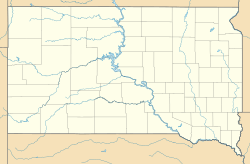Molstad Village facts for kids
|
Molstad Village
|
|

Aerial view of the site
|
|
| Location | Western side of the Missouri River, 6 miles (9.7 km) southeast of Mobridge, South Dakota |
|---|---|
| Area | 9.9 acres (4.0 ha) |
| NRHP reference No. | 66000713 |
Quick facts for kids Significant dates |
|
| Added to NRHP | October 15, 1966 |
| Designated NHL | July 19, 1964 |
Molstad Village, also known as 39DW234, is a special archaeological site in Dewey County, South Dakota. It is located close to the city of Mobridge. In 1964, this site was recognized as a National Historic Landmark. This means it is a very important place in American history.
Discovering Molstad Village
Molstad Village was found on the ranch of Irene and Oscar Molstad. Irene Molstad was a member of the Cheyenne River Sioux Nation. She and her husband Oscar ran a cattle ranch. They allowed researchers from the Smithsonian Institution to stay on their land.
These researchers were looking for old sites before Lake Oahe was created. Lake Oahe is a large reservoir formed by a dam on the Missouri River. The Molstad village site was dug up by this team in 1962. J. Jake Hoffman led the excavation work.
What Was Found at Molstad Village?
The Molstad Village site shows the remains of a small Native American village. It had earth lodges, which were homes built partly underground. These homes were surrounded by a strong fence called a palisade. This fence likely had special lookout points called bastions. Other lodges were found outside this main fenced area.
Scientists believe the village was used for a short time in the mid-1500s CE. This period is known as the Extended Coalescent phase for Native American groups in the area.
During the dig, four lodge sites were carefully explored. Researchers found post holes, which are marks left by wooden posts that held up the lodges. They also found cache pits. These were underground storage areas used to keep food and tools safe.
Many interesting items were discovered at the site. These included pieces of pottery and tools made from stone. Bone tools were also found. Some of these bone tools were plows, which were made from the shoulder blades of bison. These tools helped people farm the land.
The items found at Molstad Village were very important. They helped J. Jake Hoffman understand how different Native American groups lived over time in that region. He used the styles of pottery to create a timeline of other nearby sites.



